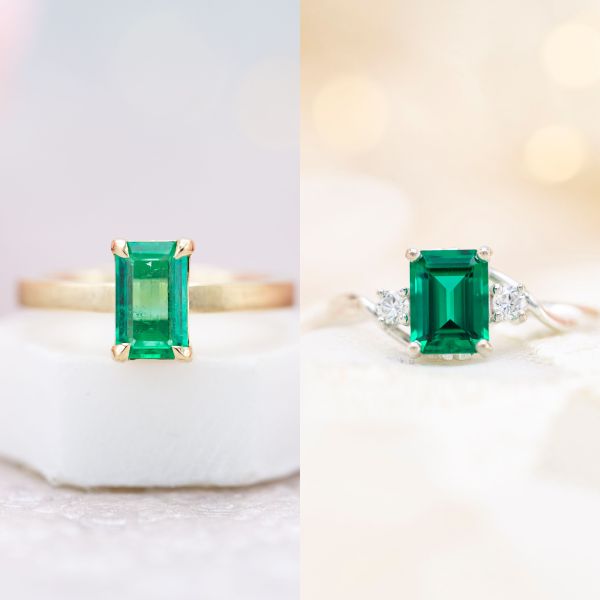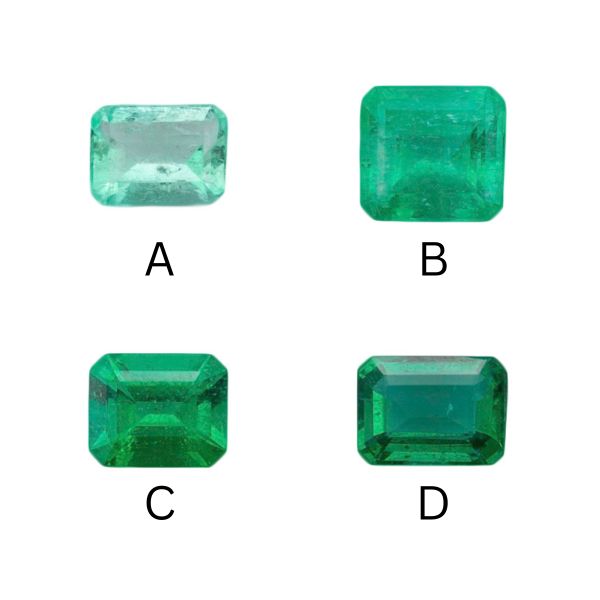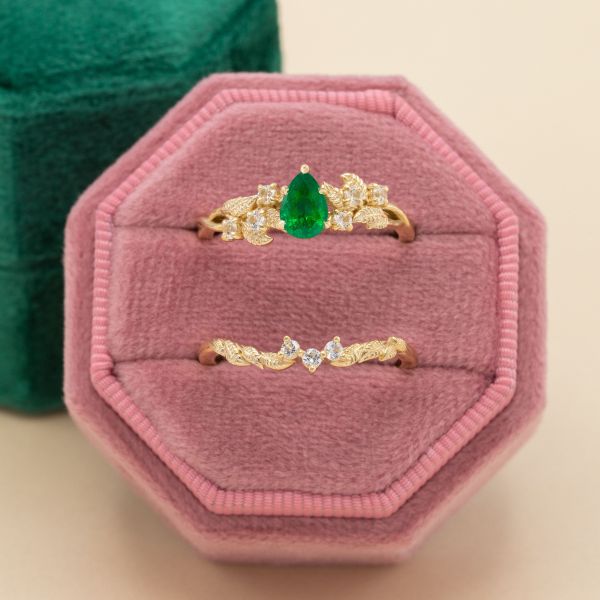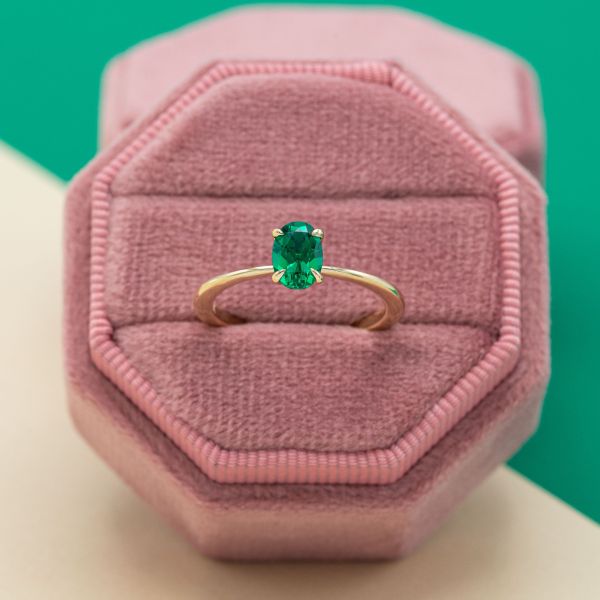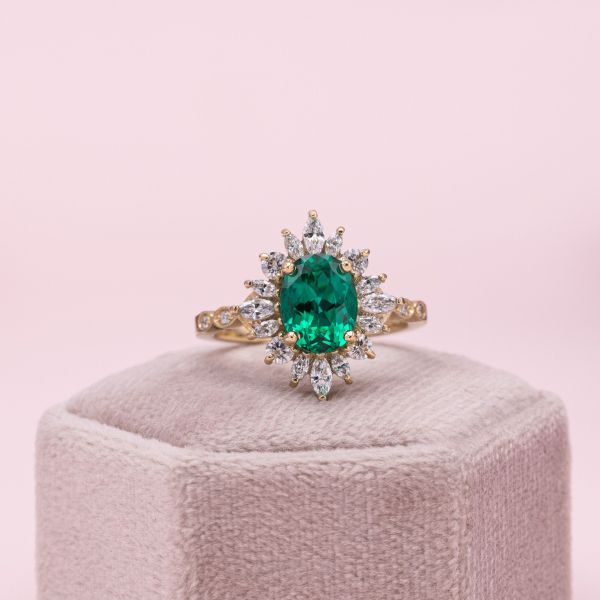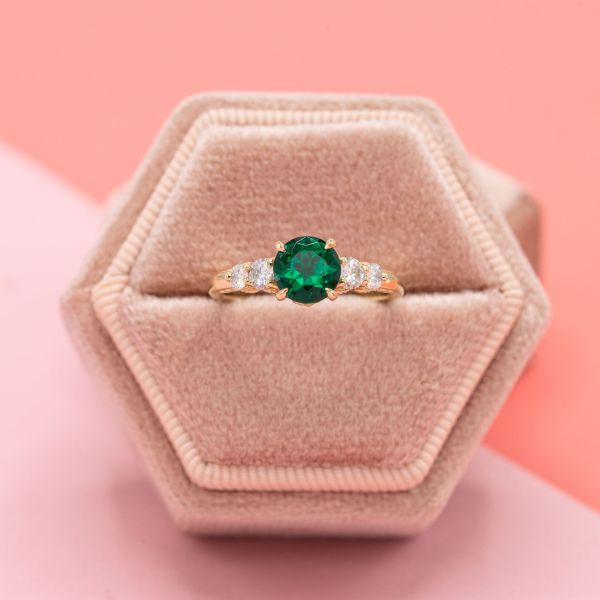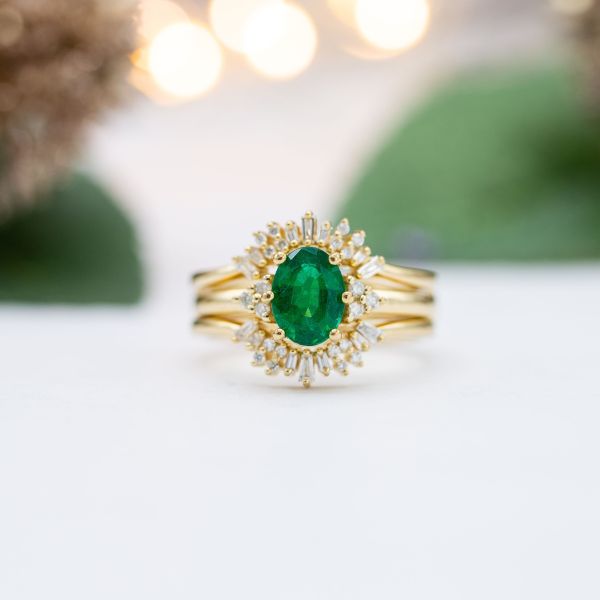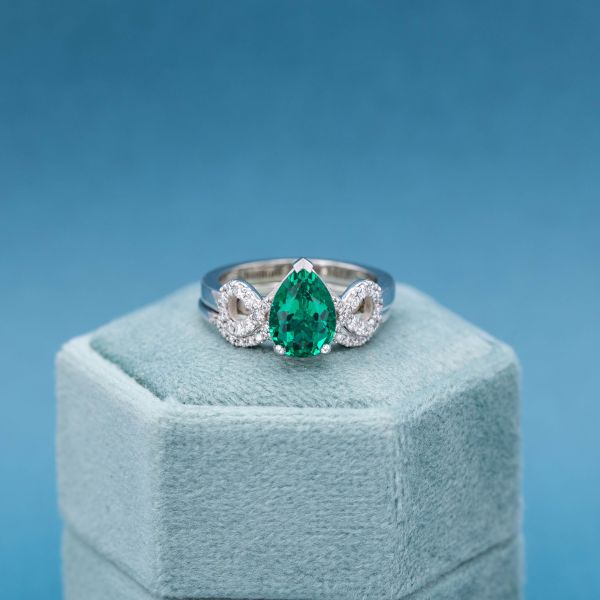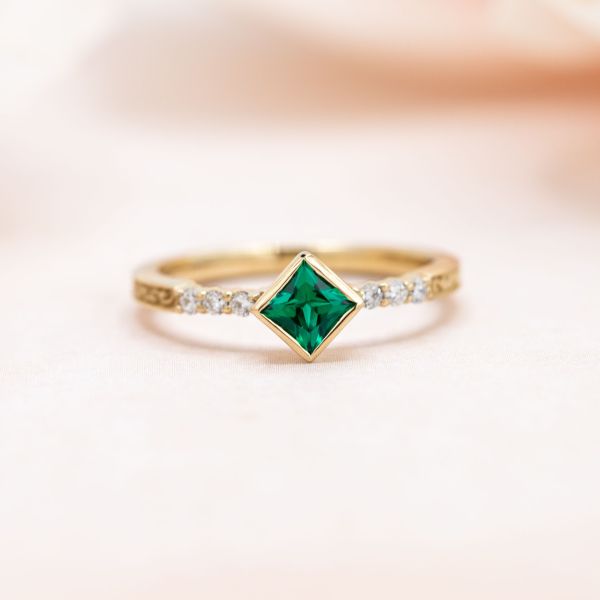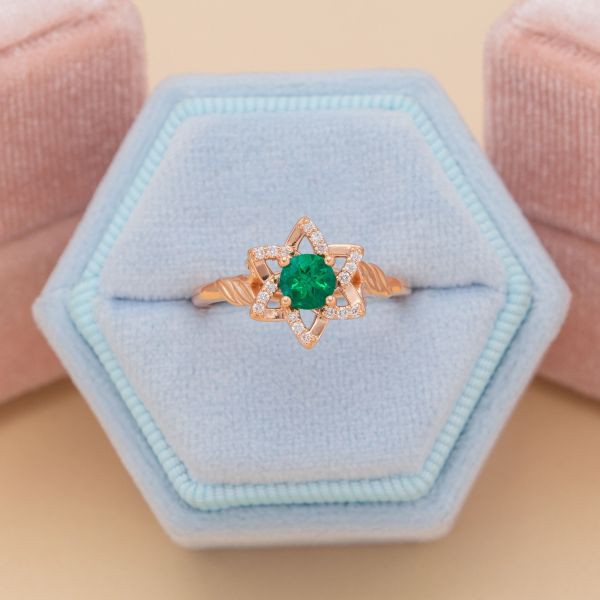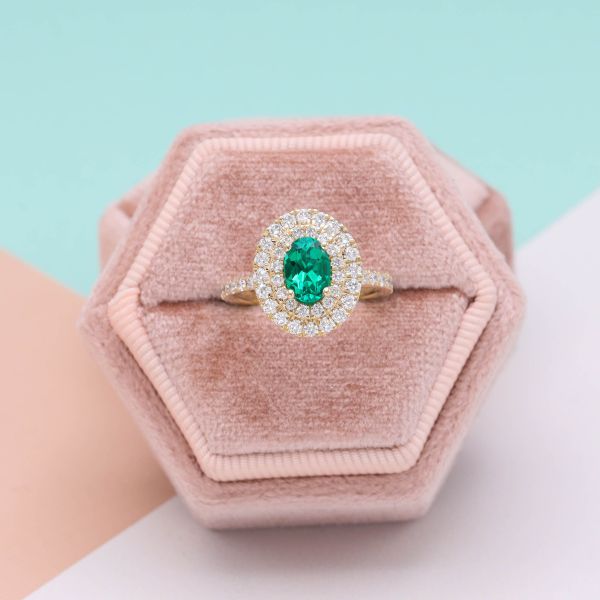Gemstone Knowledge
How to pick the perfect emerald
Suggestions on selecting the right emerald for your engagement ring
Have you decided on an emerald engagement ring for you or your partner? Congrats! Few can resist the luscious green color of stately emerald, and much like the love stories of our couples, every stone is unique and special. Now that you’ve decided to pursue an emerald for your ring, it’s time to think about some of the specifics, like balancing your emerald’s visual appeal and your budget, whether you’d like a natural or lab stone, and of course what size and shape is fit for your style. There’s a lot to consider, but that’s where our expertise comes in! Let’s take a look at some of the finer points of emerald selection, particularly:
- Should you opt for a natural or lab emerald? Which one will better suit your needs?
- How can you balance quality and value in emeralds when it comes to important visual characteristics like color, clarity, and size?
- What about the other fun decisions like exact color, shape, and setting?
Natural or lab?
Let’s start by asking the hard question: natural or lab emeralds? This question really comes down to how you wish to balance your emerald’s visual and durability characteristics with price. Lab emeralds are a fantastic option for couples who don’t want to sacrifice quality or durability while sticking to their budget. Natural and lab emeralds are the same when talking about chemical structure, but there are a few key differences that we want to highlight as you think through your decision regarding which one is right for your needs:
- Natural emeralds have jardin (internal fractures) and lab emeralds do not. The jardin in natural emeralds looks like pretty green threads running through the stone, but it makes them more susceptible to damage over time. Still, jardin gives each stone a unique personality. No two natural emeralds look the same!
- Lab emeralds have uniform quality, providing the slightly bluish green hue of “top color” stones with enhanced durability thanks to their lack of jardin.
- Natural emeralds are more expensive than lab emeralds and may not fit every budget, but some couples prefer that one-of-a-kind look that comes with natural stones.
- For the best of both worlds (beauty and budget), lab emeralds are tough to beat. But, you may find a natural emerald that meets your needs if you want that jardin appeal and can find a reasonable balance between quality and value.
While that’s the gist of it, there’s a good deal to dive into for all that makes these chemical twins different, and we’ve covered it in detail in our natural vs. lab emerald guide. Now, let’s get into the next big debate: quality vs. budget!
Balancing quality and value with emeralds
Color
Color is the first thing most of us notice about a gemstone, and emeralds are known for their cool green hue with strong saturation. In fact, that lush green appearance is the reason many couples fall so hard for emeralds and are willing to pay a bit more for the stone of their dreams. That being said, that traditional emerald green color can come at a surprising price for natural stones, and so it’s important to think about finding the “happy medium” between quality characteristics and cost. We like to help our clients focus on a balance between great quality and great value, but which green stone you like is entirely up to your own personal tastes!
For instance, take a look at the four natural emeralds below:
Option D in this lineup features what’s often referred to as “top color” and is the shade we associate with classic “emerald green”. Upon closer inspection, it’s actually a green hue with about 10% to 15% blue undertones and strong saturation for a concentrated display of vivid color and a subtle blue-green appearance. However, natural emeralds with “top color” are also rare, pricey, and highly sought after for their high-quality hue, so they may not be the best fit for every couple.
That being said, options A, B, and C in this list are also lovely stones with diverse variations on emerald’s color, and one of them may catch your eye. Option B is a great balance of value and size with its medium green color, so it may be a “happy medium” for some couples looking to balance that green appeal with their budget. And, options A and C offer unique and unexpected takes on emerald’s green hue, with C offering a slight discount thanks to its yellow undertones and A coming in at a very reasonable price overall.
Speaking of color variations, if you opt for a lab emerald, you can expect fewer variations in undertone hue and saturation since they’re optimized for high-quality color. Remember that lab emeralds are always a great option for those looking to keep with the true, lush emerald green stone but stick to a lower budget. The most important thing is to trust your eye! We can tell you what to look for to get the industry standard for “top color,” but at the end of the day what’s important is to get an emerald that you love the look of.
Clarity
When it comes to clarity, natural emeralds are notorious for their inclusions, but these inclusions (remember the jardin we talked about earlier?) are actually a big part of why many couples opt for this green stone in the first place! These silky fractures give each stone its own personality and are an inevitable piece of natural emeralds. As such, natural emeralds with high-quality clarity often come at a premium, and most natural stones will have some level of visible inclusions that impact price accordingly.
But, jardin can also be colorless or located near the edges of the stone where it’s less noticeable, so not every fragment of jardin is immediately visible and you may find a stone with subtle jardin that fits your budget. All this to say that if you’re dead set on a natural emerald, you should take a look at several stones and compare the visual appeal of their jardin before choosing one. That’s why we take professional photos with proper lighting in a controlled environment of all emeralds we source to give you a better idea of how each stone looks so you can make an informed decision!
When discussing whether emeralds are a good choice for engagement rings, we mentioned how jardin can also make natural emeralds more fragile. As such, we focus on stones with minor to moderate clarity treatments to improve durability and assist with maintenance over time, since most natural emeralds require oil or resin treatments to reduce the visual and durability impacts of jardin.
After all this jardin jargon, what if you still want an emerald without noticeable inclusions, don't want to worry about its durability, and want to keep to a reasonable budget? Well well, don’t we like to have our cake and eat it too? Luckily, that's where lab emeralds pop back into the picture because of their high-quality color and clarity with enhanced durability for a fraction of the cost. If you’re looking for the perfect, spotless emerald at a budget friendly price, lab emeralds might be for you.
Size
Once you’ve decided whether you want a lab or natural stone and balanced color and clarity with your budget, you’ll also have to think about what size emerald you’d like, as this has a major impact on price—specifically for natural emeralds. While we’d all love a giant emerald to parade around and show our family and friends, a high-quality natural emerald is rare at any size, so it makes sense that larger emeralds command much higher prices. In fact, a 1 carat natural emerald with good-quality color and clarity can cost anywhere from $1,750 to $4,000. And if you’re looking to size up, prices jump at the 2, 3, 5, 8, and 10 carat mark (And yes, we will call you boujee if you’re opting for a 10 carat emerald. You go girl!).
On a positive note, emeralds are actually less dense than diamonds, which means your stone will appear visually larger at the same carat weight. And, if these prices are making your palms a little twitchy, it can be comforting to know that lab emeralds cost a fraction of the price of their natural counterparts. For a 1 carat lab stone of similar quality, you’re looking at a price of $625-$675—less than half of the cost of a natural emerald in some cases! So if you’re looking at bumping up those carats 2 or 3, choosing a lab emerald can make that decision much more palatable on almost any budget. In that case, you can even go for those 5, 8, and 10 carat rocks guilt-free!
Other considerations for emeralds
Color variations
While many couples seek natural and lab emeralds with that signature bluish green color, beauty is in the eye of the beholder, and what looks amazing to one person may not quite fit the bill for another. In addition to finding the balance between quality and value, it’s important to find an emerald with a color that you and your partner love.
For instance, changes in saturation and tone can transform an emerald into something entirely different! If you prefer brighter colors, the springy hue of an emerald with yellow undertones may be ideal for you. Or, perhaps you love pastels like mint green, in which case you can get a stone with light saturation and an open tone for a pale, delicate aesthetic. So are you a classic emerald lover, a grassy green queen, or something in between? While those bluish green hues may be considered “top color”, it’s important to choose an emerald with a color that speaks to your personal tastes.
Setting, shape, and cut
So what type of setting should you choose for your stunning green stone? Natural and lab emeralds alike can generally suit any setting, but the undertones of your stone might pop better with certain metals over others. For instance:
- Emeralds with blue undertones have a cool aesthetic that works well with icy-toned metals like white gold and platinum.
- Emeralds with yellow undertones offer a grassier take on the traditional cool green and pair well with warm yellow gold.
While these may be popular combinations, there’s no reason you can’t place an emerald with blue undertones in a yellow gold setting or vice versa if that’s what you want. It all comes down to the look you’re trying to achieve with your emerald engagement ring, so get creative!
The lush green of emeralds lends itself well to nature-inspired settings, with some stones mimicking the colors of new buds in spring or summer foliage. If you’re looking to add a floral theme to your ring or incorporate your partner’s favorite flower–such as lavender or rose–don’t be afraid to include emerald accent stones in your design!
And what about your setting? Because emeralds are often emerald cut (that’s where the cut name comes from, duh!) due to beryl’s natural structure, they stand tall and proud in solitaire settings. But, that doesn’t mean you can’t add a pop of sparkle if you’d like! Rich green emeralds in brilliant and step cuts alike look lovely when surrounded by a few diamond or moissanite accent stones, or even an entire halo of them.
When it comes to shape, the most popular cuts for emeralds are round, pear, oval, marquise, and—of course—the emerald cut. These shapes offer a nice variety, and couples can choose the cut that highlights the characteristics of emeralds they love most! Brilliant cuts give emerald’s luscious green color a soft prismatic sparkle, whereas a sophisticated step cut like the emerald cut provides depth and a closer look at all of those shadows and facets. Emerald cuts also sport an elongated silhouette that appears visually larger and can make your finger look longer and slimmer, making them a great option for us small-handed wearers!
Finally, as you inspect potential emeralds, be on the lookout for any “windowing” or lighter areas of color in the center or near the edges of the stone. Windowing occurs when an emerald receives a shallow cut, creating lighter spots that can put a damper on that gorgeous green aesthetic. Smaller windows aren’t as much of a concern, but larger ones can certainly impact overall appeal.
Another issue to be on the lookout for is “extinction”. Don’t worry: your emerald isn’t going to go the way of the dinosaurs, never to be seen again! Instead, “extinction” in gemstones means that facet angles don’t let light bounce back out of the stone, causing darker areas to appear and making it less sparkly. To be fair, a little light and dark is a good thing (scintillation, anyone?!), but if these light or dark areas make up more than 25% of your stone’s surface you may want to consider a different emerald. Otherwise, as long as the stone is symmetrical and proportional, pick the one that’s the best fit for your situation!
Check out individual stones
So are you all in on emeralds? Whether you’ve chosen a natural emerald or a lab stone, it can be helpful to take a careful look at each one you’re considering to see if it offers the color and appeal you imagine when daydreaming about your (or your partner’s) future emerald engagement ring. If you have your heart set on a natural emerald, looking at individual stones is even more important! Because jardin gives each emerald a one-of-a-kind look, it’s crucial to review each stone and see if the pattern of internal inclusions is to your liking. Like we mentioned before, we take all of our gemstone photos in a controlled environment with proper lighting so you can focus less on getting a good look at each emerald and more on choosing the right stone for your custom engagement ring!
About CustomMade
CustomMade designs and creates one-of-a-kind, custom engagement rings and fine jewelry. Each piece we create is inspired by you, designed for you, and made just for you.
